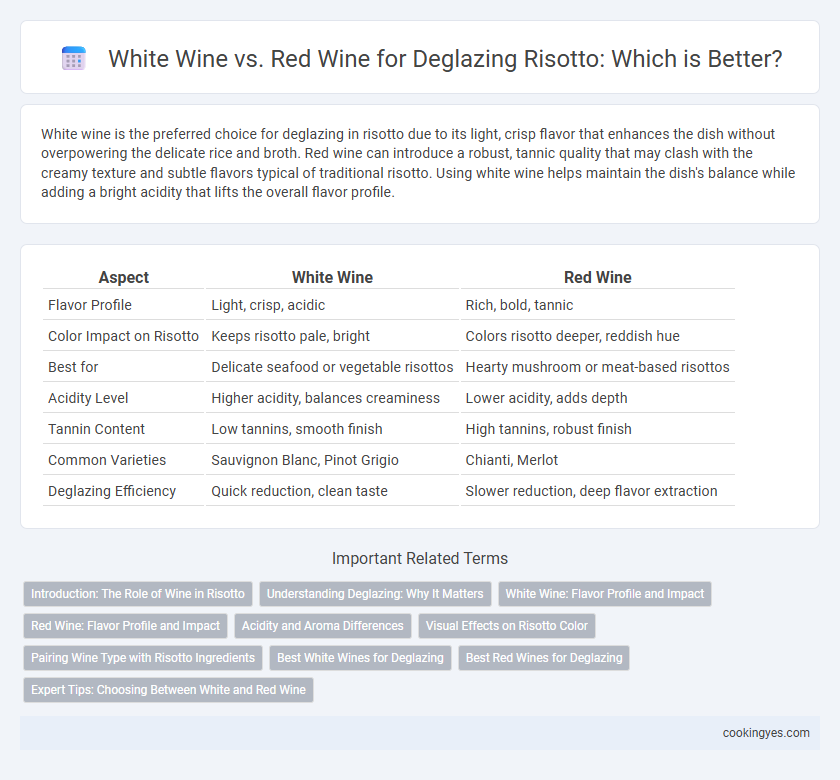White wine is the preferred choice for deglazing in risotto due to its light, crisp flavor that enhances the dish without overpowering the delicate rice and broth. Red wine can introduce a robust, tannic quality that may clash with the creamy texture and subtle flavors typical of traditional risotto. Using white wine helps maintain the dish's balance while adding a bright acidity that lifts the overall flavor profile.
Table of Comparison
| Aspect | White Wine | Red Wine |
|---|---|---|
| Flavor Profile | Light, crisp, acidic | Rich, bold, tannic |
| Color Impact on Risotto | Keeps risotto pale, bright | Colors risotto deeper, reddish hue |
| Best for | Delicate seafood or vegetable risottos | Hearty mushroom or meat-based risottos |
| Acidity Level | Higher acidity, balances creaminess | Lower acidity, adds depth |
| Tannin Content | Low tannins, smooth finish | High tannins, robust finish |
| Common Varieties | Sauvignon Blanc, Pinot Grigio | Chianti, Merlot |
| Deglazing Efficiency | Quick reduction, clean taste | Slower reduction, deep flavor extraction |
Introduction: The Role of Wine in Risotto
Wine plays a crucial role in risotto by enhancing flavor and balancing richness during the deglazing process. White wine is preferred for its acidity and lightness, which brightens the dish without overpowering the creamy texture. Red wine, while less common, can add depth and robust notes but may alter the risotto's traditional delicate profile.
Understanding Deglazing: Why It Matters
Deglazing with white wine in risotto enhances the dish by adding acidity and brightness that complements the creamy texture and delicate flavors of Arborio rice. Red wine, with its stronger tannins and deeper color, can overpower the subtle taste of risotto and is less commonly used in this culinary technique. Mastering the choice of white wine for deglazing is crucial for achieving the perfect balance and depth in traditional risotto recipes.
White Wine: Flavor Profile and Impact
White wine is the preferred choice for deglazing in risotto due to its higher acidity and crisp, light flavor profile, which enhances the dish without overpowering the delicate rice and broth. The subtle fruity and citrus notes of dry white wines like Pinot Grigio or Sauvignon Blanc complement the creamy texture and help balance the richness of the dish. Using white wine in risotto creates a bright, nuanced flavor that preserves the traditional Italian essence of this classic rice dish.
Red Wine: Flavor Profile and Impact
Red wine adds a rich, robust flavor to risotto, enhancing the dish with deep berry and plum notes along with subtle tannins that create complexity. Its intense color can darken the risotto slightly, contributing to a heartier appearance. Choosing red wine for deglazing influences the final texture and flavor intensity, making the risotto bold and full-bodied compared to the lighter, more acidic profile from white wine.
Acidity and Aroma Differences
White wine offers higher acidity that enhances risotto's brightness and preserves subtle flavors, while its light, crisp aroma complements delicate ingredients like seafood or vegetables. Red wine provides deeper, fruitier aromas with lower acidity, adding richness and a robust profile suited for heartier risottos featuring mushrooms or meats. The choice impacts the final dish's balance, where acidity influences texture and aroma drives flavor complexity.
Visual Effects on Risotto Color
White wine deglazing preserves risotto's creamy, pale appearance, enhancing its delicate texture and visually appealing light color. Red wine can impart a rich, ruby tint, creating a more vibrant but darker hue that may alter the dish's traditional look. Choosing white wine maintains the classic golden-white risotto aesthetic preferred in many Italian recipes.
Pairing Wine Type with Risotto Ingredients
White wine is preferred for deglazing risotto as it enhances delicate flavors, especially with seafood, chicken, or vegetable-based risottos, by adding a crisp acidity without overpowering the dish. Red wine suits heartier risottos featuring mushrooms, beef, or game, contributing rich tannins and deeper color that complement robust, earthy ingredients. Selecting the wine type based on risotto ingredients ensures balanced flavor integration and elevates the overall dining experience.
Best White Wines for Deglazing
Best white wines for deglazing risotto include dry and acidic varietals like Sauvignon Blanc, Pinot Grigio, and Chardonnay with minimal oak influence. These wines enhance the dish by lifting flavors and adding brightness without overpowering the subtle creaminess of the risotto. Avoid sweet or heavily oaked wines, as they can alter the balance and texture of the final dish.
Best Red Wines for Deglazing
When choosing red wines for deglazing risotto, opt for light-bodied varieties like Pinot Noir or Barbera, as their acidity enhances the dish without overpowering the creamy texture. These wines release flavorful tannins and fruity notes that meld seamlessly with sauteed onions and mushrooms. Avoid heavy, oaky reds, as their robust flavors can dominate the delicate balance of risotto ingredients.
Expert Tips: Choosing Between White and Red Wine
Experts recommend white wine for deglazing risotto due to its higher acidity and lighter flavor, which enhance the dish without overpowering the delicate rice. Red wine, with its robust tannins and deeper color, may overwhelm the subtle flavors and alter the texture. For optimal results, choose a dry white wine such as Sauvignon Blanc or Pinot Grigio to achieve a balanced and aromatic risotto.
White wine vs Red wine for deglazing Infographic

 cookingyes.com
cookingyes.com